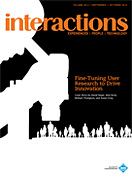Authors:
Rodrigo Carvalho
For centuries, artists, scientists, writers, designers, engineers, and others have explored audiovisual environments to create augmented realities and temporary autonomous spaces. The constant evolution of new media technologies provides the creators with better tools each day, allowing them to merge existing physical spaces with the virtualthe digital and imaginary ones. The magical features of these environments have been attracting humans since long before the advent of new media technologies. The need to understand the universe is a basic human trait, as is the more specific need to understand its rules so we can break them and create new worlds.…
You must be a member of SIGCHI, a subscriber to ACM's Digital Library, or an interactions subscriber to read the full text of this article.
GET ACCESS
Join ACM SIGCHIIn addition to all of the professional benefits of being a SIGCHI member, members get full access to interactions online content and receive the print version of the magazine bimonthly.
Subscribe to the ACM Digital Library
Get access to all interactions content online and the entire archive of ACM publications dating back to 1954. (Please check with your institution to see if it already has a subscription.)
Subscribe to interactions
Get full access to interactions online content and receive the print version of the magazine bimonthly.






